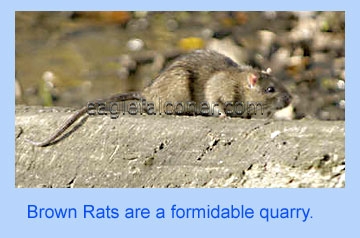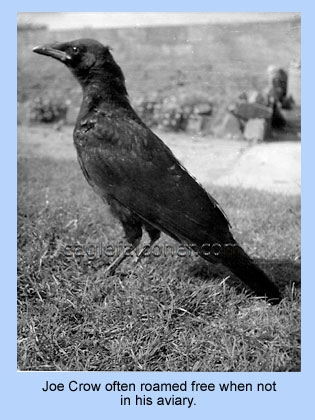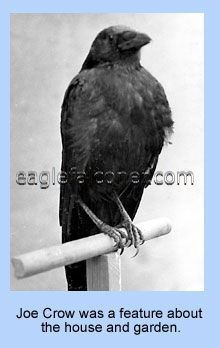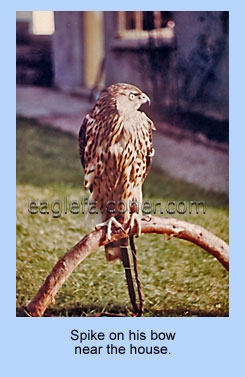'Tales of a rat hunting hawk.'
by
Alan Gates
First Published in the Austringer 1990.
As I sat at the dining-room table on lunch time, my father suddenly sprang to his feet. ‘Did you see that?, he cried out. ‘See what?, I replied. ‘Bloody great rat, he exclaimed.
From where he had been sitting, he had a good view through the window of our garden. It was a reasonable sized area with a good proportion down to lawn, this was ideally suited for my hawks, and my parents had kindly shown no objection to my gradual invasion.
 Firstly I had taken part of their vegetable plot for my mews. Although I had a sneaky suspicion that my father was grateful for the excuse to cut back on the area needed digging each year.
Firstly I had taken part of their vegetable plot for my mews. Although I had a sneaky suspicion that my father was grateful for the excuse to cut back on the area needed digging each year.
Then my hawks were perched all over the lawn, better still my father still insisted on mowing the grass every week with a push mower. He only muttered at the patches of lush nitrogen-fed grass that grew a few weeks after the hawks’ perches had been moved to another area. His complaints were not because it gave the lawn a patchy appearance, no, it was because he nearly went over the handle bars of the mower each time he hit one.
Now this sighting of a rat was nothing to do with my hawk  accommodation. It went back to the days before I kept hawks, for as a young schoolboy I had kept all sorts of birds including magpies and crows. I still had a crow and he was a great character, he was housed in an aviary alongside the mews sheds.
accommodation. It went back to the days before I kept hawks, for as a young schoolboy I had kept all sorts of birds including magpies and crows. I still had a crow and he was a great character, he was housed in an aviary alongside the mews sheds.
 Evidently this rat had decided to tunnel up through the floor of the aviary, on the prospect of helping himself to a mouthful or two of crow food.
Evidently this rat had decided to tunnel up through the floor of the aviary, on the prospect of helping himself to a mouthful or two of crow food.
The next day when Mr. Ratto put in another appearance, and my father was demanding my gun so he could blast it through the open window from where he sat. I, fearing not only my mothers washing hanging on the line, but also her garden gnomes, for I had already been wrongly blamed for using as target practise, but also my innocent hawks all being caught up in the gunfire and ricocheting pellets, proposed a compromise.
I had read in A Manual of Falconry by Mike Woodford, that rat hawking around a straw stack with a dog and goshawk was an extremely exciting event. He also proclaimed that he had never known a goshawk to be bitten by a rat.
I selected my young male goshawk, Spike. Having first made sure that ol’ Joe crow was well fastened into the shed part of his enclosure. I perched little Spike onto the main cross perch of the aviary and left him.
From where I sat at the dining table I could see Spike. He was looking a little bewildered, I imagined him thinking, ‘What's the silly blighter left me here for?’. We all settled to have lunch and I kept looking up, only to see Spike sitting there. Then up pops Mr. Ratto’s head, he looks about, to see if the coast was clear. He is not bothered by a large bird on the perch because he is use to ol’ Joe crow bouncing from perch to perch.
Spike does not seem to notice him, the family is now riveted and lunch is well and truly interrupted. Out pops  Ratto and runs to the food bowl, with a flash, Spike has him. A loud cheer from the dining table as I rush up to the aviary.
Ratto and runs to the food bowl, with a flash, Spike has him. A loud cheer from the dining table as I rush up to the aviary.
Mr. Ratto was well and truly dead when I arrived, but so much for Mr. Woodford’s comments, Spike has a bite mark on his leg. I fearing the worst with rat bites, hastily administer antiseptic cream I had from the vets. What reinforced my fears of bites was the tragic tale a friend told me. He recounted an afternoon’s hawking with his young passage male goshawk. It was a cold, grey, winter’s afternoon and he was hunting a wooded valley when he lost sight of the gos for three hours, it was now starting to get dark, and it had been drizzling four an hour or so.
Then at last the sound of a bell, he lifted his fist and whistled, out of the dark, damp woodland came the gos, as he flew towards him he noticed he was carrying something in one foot. When the gos arrived on the fist it revealed that it was a stoat that he was carrying, it was stone dead but otherwise untouched.
He though this a little strange, but was so pleased to get the gos back, he fed up the hawk and headed for home. On arriving home he put the hawk in the mews for the night, but the next morning the hawk was dead. On closer examination he found a small deep bite mark in the leg muscle, but with no other marks. A sad end, and a tale to make you a little wary.
Luckily Spike showed no ill-effects from his rat bite, but I did not repeat the episode.
Some time later I was flying Spike on a large area of marsh land. It was a good place to hunt duck and moorhens, Spike was high up in a large willow tree as I beat the reeds and rushes. Suddenly Spike was off, flying further into the marsh and then he dived into the reeds. I left where I was and chased after him. I found him on the ground on a kill, as I bet down I could see it was a large rat.
‘Oh my god’, I thought, but my fears were unfounded as Spike had ratto well and truly held. His rear talon was right through the back of the skull with his large front and middle talons either side of his nostrils.
We caught a number of rats on quarry rubbish tips and every time Spike caught them by the head. He had learned his lesson well.
